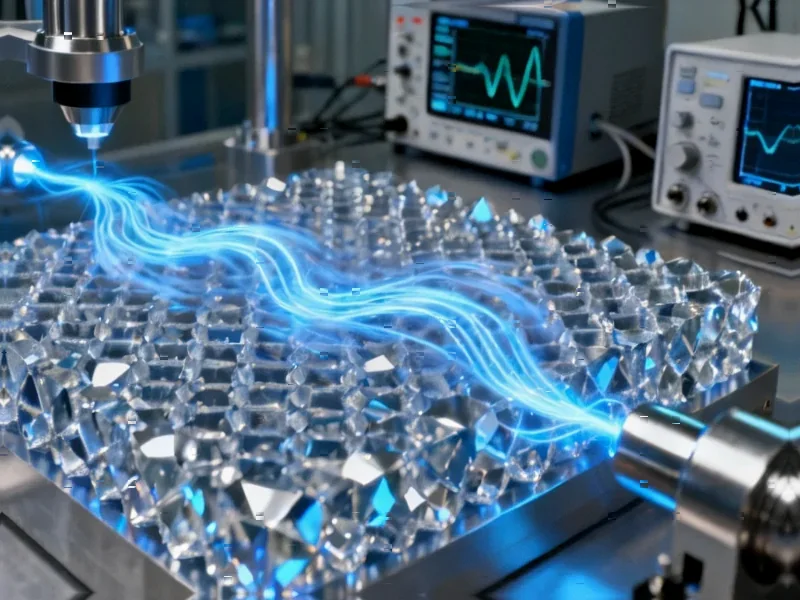According to Phys.org, researchers at CERN’s ISOLDE facility have developed a groundbreaking technique that could finally enable detailed study of superheavy elements. The team used their multi-ion reflection apparatus for collinear laser spectroscopy (MIRACLS) to trap chlorine anions and reflect them between electrostatic mirrors approximately 60,000 times, allowing repeated laser probing. This “recycling” approach achieved precision electron affinity measurements using 100,000 times fewer atoms than conventional methods, overcoming the critical limitation of studying elements produced at rates of just a few anions per second. Lead authors Franziska Maier and Erich Leistenschneider emphasized that this breakthrough opens pathways to understanding how Einstein’s relativity scrambles atomic structures in superheavy elements, potentially blurring periodic table boundaries. This development signals a fundamental shift in how we approach the most elusive regions of the periodic table.
Breaking the Atom Supply Bottleneck
The fundamental challenge with superheavy elements has always been scarcity – these elements are so unstable that researchers might only produce a handful of atoms per day, sometimes less. Traditional analytical methods require thousands or millions of atoms to gather statistically significant data, creating an impossible barrier for studying elements beyond lawrencium. What makes the MIRACLS approach revolutionary isn’t just the precision, but the radical efficiency improvement. By effectively multiplying the utility of each individual atom by 60,000 through repeated measurements, researchers can now extract meaningful data from samples that were previously considered useless for detailed chemical analysis. This represents a paradigm shift similar to how PCR amplified tiny DNA samples into analyzable quantities in molecular biology.
Relativity’s Chemical Revolution
When Leistenschneider mentions that “Einstein’s relativity scrambles the structure of the atoms,” he’s referring to one of the most profound unsolved questions in chemistry. In superheavy elements with atomic numbers above 100, electrons move at significant fractions of light speed around massive nuclei. This causes relativistic effects where electrons gain mass and contract toward the nucleus, fundamentally altering how these elements form bonds and react chemically. We might discover that elements we assumed would behave like their lighter periodic table counterparts actually have completely unexpected properties. The Nature Communications paper represents the first practical tool to systematically investigate these effects rather than just theorizing about them.
Medical Isotopes and Beyond
The implications extend far beyond fundamental physics. The same scarcity problem that plagues superheavy element research also affects medical isotopes like actinium-225, which shows tremendous promise for targeted alpha therapy cancer treatments but is incredibly rare and expensive to produce. The MIRACLS methodology could enable researchers to study the chemical behavior of these precious medical isotopes using minuscule quantities, accelerating drug development and potentially reducing costs. This represents a rare convergence where cutting-edge fundamental physics directly enables advances in life-saving medical technology.
Antimatter and Symmetry Testing
Perhaps the most forward-looking application lies in antimatter research. Understanding why our universe contains mostly matter rather than equal parts matter and antimatter remains one of physics’ greatest mysteries. CERN’s antimatter research program depends on precisely understanding molecular properties, but studying antimatter molecules presents even greater scarcity challenges than superheavy elements. The ability to extract maximum information from minimal samples could be the key to testing fundamental symmetries of nature. Over the next decade, we’ll likely see this anion recycling technique adapted to study radioactive molecules and eventually antimatter counterparts, potentially revealing why we exist in a matter-dominated universe.
The Periodic Table Redrawn
Looking ahead 5-10 years, this breakthrough could fundamentally reshape our understanding of chemical periodicity. We’re approaching the point where we can systematically study elements 104 through 118 with the same precision we currently apply to common elements. The periodic table, which has served as chemistry’s foundational framework for 150 years, might require significant revision in its heaviest regions. We may discover entirely new categories of chemical behavior or find that groups we thought were well-understood behave completely differently under extreme nuclear conditions. This isn’t just about filling in blanks – it’s about potentially rewriting the rules of chemistry itself.





I don’t think the title of your article matches the content lol. Just kidding, mainly because I had some doubts after reading the article.